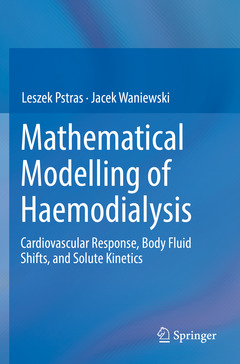Contents
1. INTRODUCTION ................................................................................................................................ 1
1.1. KIDNEY FUNCTION ....................................................................................................................... 1
1.2. CHRONIC KIDNEY FAILURE .......................................................................................................... 2
1.3. HAEMODIALYSIS .......................................................................................................................... 5
1.4. CLINICAL PROBLEMS IN HAEMODIALYSIS .................................................................................... 7
1.5. MATHEMATICAL MODELLING .................................................................................................... 10
REFERENCES ....................................................................................................................................... 13
2. MODEL DESCRIPTION ................................................................................................................... 17
2.1. OVERVIEW ................................................................................................................................. 17
2.2. CARDIOVASCULAR SYSTEM ....................................................................................................... 18
2.2.1. Cardiovascular compartments ..................................................................................... 18
2.2.2. Vascular resistance ...................................................................................................... 20
2.2.3. Cardiac output ............................................................................................................. 22
2.2.4. Baroreflex .................................................................................................................... 24
2.2.5. Haematocrit ................................................................................................................. 29
2.2.6. Arteriovenous access ................................................................................................... 31
2.2.7. Assumptions ................................................................................................................ 32
2.3. WATER AND SOLUTE KINETICS .................................................................................................. 33
2.3.1. Fluid compartments ..................................................................................................... 33
2.3.2. Small solute kinetics .................................................................................................... 34
2.3.3. Capillary filtration ....................................................................................................... 38
2.3.4. Protein transport .......................................................................................................... 42
2.3.5. Lymph flow ................................................................................................................. 43
2.3.6. Cellular water transport ............................................................................................... 44
2.3.7. Dialyzer mass exchange .............................................................................................. 46
2.3.8. Blood mixing ............................................................................................................... 47
2.4. MODEL INTEGRATION ................................................................................................................ 49
2.5. PARAMETERS ASSIGNMENT ........................................................................................................ 50
2.5.1. Cardiovascular system parameters .............................................................................. 50
2.5.2. Transport parameters ................................................................................................... 53
2.6. INITIAL CONDITIONS .................................................................................................................. 55
2.6.1. Normal man ................................................................................................................. 55
2.6.2. Patient before dialysis.................................................................................................. 59
2.7. HAEMODIALYSIS MODELLING .................................................................................................... 64
2.8. COMPUTATIONAL IMPLEMENTATION ......................................................................................... 66
REFERENCES ....................................................................................................................................... 67
3. MODEL ANALYSIS .......................................................................................................................... 77
3.1. SENSITIVITY ANALYSIS .............................................................................................................. 77
3.1.1. Overview ..................................................................................................................... 77
3.1.2. Sensitivity to assigned parameters ............................................................................... 81
3.1.3. Sensitivity to equation parameters ............................................................................... 85
3.2. MODEL VALIDATION .................................................................................................................. 88
3.2.1. Lublin data ................................................................................................................... 88
3.2.2. Literature data .............................................................................................................. 96
3.3. MODEL LIMITATIONS ............................................................................................................... 100
REFERENCES ..................................................................................................................................... 102
4. SIMULATION RESULTS ............................................................................................................... 104
4.1. HAEMODYNAMICS ................................................................................................................... 104
4.2. VASCULAR REFILLING ............................................................................................................. 107
4.3. WATER SHIFTS ......................................................................................................................... 110
4.4. SOLUTE KINETICS .................................................................................................................... 111
4.5. HAEMATOCRIT CHANGES ......................................................................................................... 114
4.6. IMPACT OF BAROREFLEX AND CARDIAC PARAMETERS ............................................................. 116
4.7. IMPACT OF DIALYSIS SETTINGS ................................................................................................ 121
REFERENCES ..................................................................................................................................... 122
5. CONCLUSIONS ............................................................................................................................... 124
REFERENCES ..................................................................................................................................... 126





